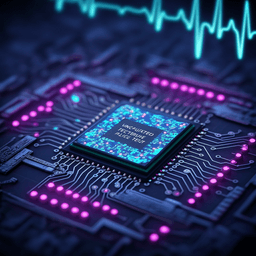
Engineering and Technology
A skin-conformal and breathable humidity sensor for emotional mode recognition and non-contact human-machine interface
T. Li, T. Zhao, et al.
Discover an innovative skin-conformal humidity sensor that not only detects emotions but also enables a non-contact human-machine interface. Developed by Tongkuai Li and colleagues, this advanced sensor adapts seamlessly to the skin, ensuring comfort and high sensitivity in recognizing emotional states through humidity changes.
~3 min • Beginner • English
Introduction
Wearable humidity sensors enable noncontact detection of ambient and skin-surface humidity with applications in healthcare monitoring, human–machine interfaces (HMI), sentiment analysis, sports, and safety. Conventional devices typically deposit humidity-sensitive materials on polymer films such as PI, PET, or PDMS. These substrates often lack breathability, impeding sweat evaporation and causing irritation or allergy during long-term wear. Their relatively large thickness and mechanical mismatch to skin also reduce conformal contact, especially on curved body regions, degrading measurement fidelity. Porous and air-permeable substrates (paper, fabric, electrospun nanofibers) improve breathability but may remain too thick for conformal contact or exhibit slow response and limited humidity range. The research question is how to realize an ultrathin, skin-conformal, breathable humidity sensor that maintains high sensitivity and fast response. The authors propose a device based on ultrathin electrospun SBS nanofibers (mechanically matched to skin) and an alkalized MXene/polydopamine (AMP) composite with high specific surface area and abundant hydroxyl groups, aiming to achieve comfortable long-term wear, high performance, and reliable monitoring of respiration-related motional and emotional states and noncontact HMI.
Literature Review
Prior approaches used polymer films (PI, PET, PDMS) as substrates for humidity sensors, offering good sensitivity and reliability but poor breathability and limited conformal contact. Breathable substrates such as paper and fabrics enhance comfort and evaporation (e.g., fabric-based breathability ~0.320 g cm⁻² d⁻¹), yet their thickness (~340 µm) hinders skin conformability, reducing accuracy. Electrospun nanofiber substrates provide ultrathin, porous structures: for example, PVA nanofiber/Au humidity sensors achieved micrometer-scale thickness and breathability ~0.113 g cm⁻² d⁻¹ but suffered slow response/recovery (148 s/110 s) and a limited response range (<30%) due to slow swelling–deswelling kinetics. PI’s critical conformal thickness is ~25 µm, indicating the need for thinner, softer substrates. MXenes have shown strong humidity responses but can oxidize; surface functionalization (e.g., polydopamine) can improve stability. This work builds on these advances to combine ultrathin, breathable nanofibers with a stable, hydrophilic MXene composite to overcome prior trade-offs among comfort, conformability, and sensing performance.
Methodology
Device design: The SAMP humidity sensor comprises an alkalized MXene/polydopamine (AMP) composite deposited over Ag nanowire (Ag NW) interdigital electrodes (IDEs) on an ultrathin electrospun poly(styrene‑block‑butadiene‑styrene) nanofiber (SBS NFs) substrate. Sensing follows the Grotthuss mechanism: water adsorption creates conductive pathways, decreasing resistance.
Synthesis of AMP composite: MAX (Ti3AlC2) powder (2 g) was etched by adding 20 mL HF dropwise and stirring for 24 h at 50 °C. The dispersion was washed to pH ~6, then dried at 110 °C for 12 h under vacuum to obtain multilayer MXene. For alkalization, 80 mg MXene was stirred in 20 mL 5 M NaOH for 2 h and dried at 70 °C for 10 h to yield alkalized MXene (AM). AM was mixed with Tris buffer (pH 8.5) for 2 h; dopamine hydrochloride was added in an ice bath (10 min) and polymerized for 24 h under stirring. After centrifugation/washing to remove free PDA and Tris, AMP suspension was obtained.
Preparation of SBS nanofiber substrate: SBS particles were dried (50 °C, 12 h). A 14 wt.% SBS solution in THF/DMF (3:1) was stirred 4 h at RT. Electrospinning used 14 kV across a 27 G needle, 0.3 mL h⁻¹ feed rate, and 12 cm tip-to-collector distance. Fibers were collected on a silicone-coated paper-wrapped roller (radius 4 cm) for 15 min, then dried in a fume hood for 2 h.
Electrode patterning and sensor assembly: A 100 µm thick PET frame with rectangular apertures was laminated to the SBS NFs to aid transfer. Ag NW ethanol dispersion was air‑sprayed through a stainless-steel mask to pattern IDEs on SBS NFs. Approximately 150 µL AMP suspension was drop‑cast onto the IDEs and dried at room temperature for 12 h to form the sensing layer. The IDE line width/spacing was ~150 µm. Ag NWs (diameter ~29 nm, length ~20 µm) formed conductive networks on SBS NFs.
Characterization: Morphologies were characterized by SEM and EDS mapping; phase and chemistry by XRD and XPS. Sheet resistance of Ag NWs on SBS NFs was measured before and after peeling. Device thickness was measured by side‑view SEM. Humidity environments were controlled in a temperature/humidity chamber; electrical characteristics were recorded with a Keithley 2600 source meter. Water vapor transmission rate (WVTR) was determined by sealing water-filled bottles with films (thickness ~26 µm for comparability) and tracking mass loss over time; WVTR = W_loss/(A·t). Dynamic contact angle and TGA were used to assess hydrophilicity and water adsorption. Mechanical robustness under stretching and bending was evaluated. Stability over 14 days at ~25% RH and 22 °C was tested. Effects of temperature and air pressure on performance were also examined.
Applications: For respiration monitoring, sensors were attached subnasally to record current waveforms under breath‑holding, resting, walking, and running. Continuous wavelet transform (CWT) extracted breathing frequency/depth. For emotional state recognition, six subjects each performed four emotions (normal, pain, fear, wonder), 30 trials per state (total 720 samples). Raw time‑domain current sequences (length 355) served as features for a support vector machine (SVM); data were split 70/30 (train/test). For noncontact HMI, a 3×3 humidity sensor array detected finger‑induced humidity fields and sliding tracks at 1–3 mm distances to issue commands to a servo‑equipped robot car via a processing circuit with wireless communication.
Key Findings
- Structure and conformability: Ultrathin sensor thickness ~26 µm on SBS NFs with Young’s modulus ~0.10 MPa (close to skin ~0.13 MPa) enables conformal skin contact; fingerprint ridges/valleys remain visible under the device.
- Electrodes and conductivity: Ag NWs on SBS NFs exhibited sheet resistance 40.1 ± 4.0 Ω sq⁻¹, increasing to 64.2 ± 7.3 Ω sq⁻¹ after peeling, indicating good conductivity and adhesion.
- Optimal AMP loading: Among AMP concentrations 0.2–1.0 mg mL⁻¹ (SAMP1–SAMP5), SAMP3 (0.6 mg mL⁻¹) achieved the best performance: detection limit 10% RH and highest sensitivity S = Rh/Rl = 704. SAMP1 and SAMP2 responded only above 30% and 15% RH, respectively.
- Breathability (WVTR): Compared at ~26 µm thickness, WVTRs (g cm⁻² d⁻¹): SAMP1–SAMP5 = 0.082, 0.079, 0.078, 0.075, 0.074; SBS NFs and SAMP devices outperformed PI, E‑30, and PDMS films. The optimal device (SAMP3) had WVTR ~0.078 g cm⁻² d⁻¹.
- Speed and hysteresis: Response/recovery times were both 0.9 s (45%→95% RH and back). Hysteresis between adsorption/desorption was small over 10–95–10% RH cycles.
- Stability and mechanics: Resistance remained relatively stable over 14 days at RT (~25% RH). Under bending to 150°, resistance changed <8%; after 500 cycles at 90° bending, resistance increased only ~4.2%. Stretching tests showed reversible resistance changes without delamination.
- Hydrophilicity and water uptake: Dynamic water contact angle on AMP side decreased from 17.76° to 14.75° over 10 s, indicating strong hydrophilicity. TGA showed ~15.2% mass loss below 100 °C for water-saturated SAMP3, consistent with high water adsorption.
- Environmental effects: Temperature had minimal effect; reduced air pressure significantly increased resistance by lowering water adsorption.
- Skin compatibility: After 8 days on skin, areas under SAMP remained normal, whereas skin under PI, E‑30, and PDMS showed erythema and edema.
- Respiration monitoring: Distinct breathing depths and frequencies under motional states: resting 2.4 ± 0.3 ×10⁻⁷ A, f = 0.173 ± 0.015 Hz; walking 3.3 ± 0.5 ×10⁻⁷ A, f = 0.29 ± 0.025 Hz; running 4.0 ± 0.5 ×10⁻⁷ A, f = 0.37 ± 0.034 Hz. No periodic signal during breath-holding. Reliable long-duration monitoring (65 min) demonstrated.
- Emotional state recognition: Using SVM on raw current sequences (355 features), four breathing pattern classes (normal, pain, fear, wonder) were recognized with 86.7% accuracy.
- Noncontact HMI: Finger proximity produced distance-dependent currents (1–3 mm). A 3×3 array detected sliding tracks (e.g., 8‑5‑2) to command a robot car to move forward/backward, turn, and open/close a clamp to transport a medical kit.
Discussion
The study addresses the challenge of creating a long-term wearable humidity sensor that is both skin-conformal and breathable without sacrificing sensitivity and speed. Electrospun SBS nanofibers provide an ultrathin, porous substrate with mechanical properties matched to skin, enabling intimate, irritation-free contact and efficient sweat evaporation. The AMP composite leverages MXene’s high surface area and PDA’s abundant hydroxyl groups to enhance hydrophilicity and water adsorption, yielding strong and rapid humidity responses. Optimization of AMP concentration balances sensitivity and breathability, with 0.6 mg mL⁻¹ delivering a 10% RH detection limit, high sensitivity (S = 704), and fast 0.9 s response/recovery alongside WVTR ~0.078 g cm⁻² d⁻¹. PDA coating improves MXene stability against oxidation, supporting two-week stability.
Functionally, the sensor reliably quantifies respiration depth and frequency across motional states and discriminates emotional modes using machine learning, demonstrating relevance to health monitoring and affective computing. The noncontact HMI exploits the intrinsic humidity gradient near skin to achieve touchless, contamination-free control of a robot car via finger gestures, expanding the modality of HMIs to humidity fields. While environmental pressure significantly influences performance by altering adsorption, the device exhibits minimal temperature sensitivity and robust mechanical durability. Overall, the findings validate that combining a skin-matched breathable substrate with a hydrophilic, stabilized MXene composite effectively meets the design goals for comfortable, high-performance on-skin humidity sensing.
Conclusion
This work presents a skin-conformal, breathable humidity sensor based on electrospun SBS nanofibers and an alkalized MXene/polydopamine composite. The device achieves high sensitivity (S = 704), fast response/recovery (0.9 s/0.9 s), ultrathin thickness (~26 µm), and strong breathability (WVTR ~0.078 g cm⁻² d⁻¹), enabling accurate monitoring of respiration under different motional states and recognition of four emotional states with 86.7% accuracy. A 3×3 sensor array further enables a noncontact HMI to control a robot car using finger-induced humidity fields. These results highlight the potential of breathable, skin-like humidity sensors for healthcare monitoring and touchless human–machine interaction. Future research could explore performance under wider environmental pressures, long-term stability beyond two weeks, integration with larger arrays and on-device processing, and multimodal sensing for richer affective and activity recognition.
Limitations
- Sensitivity and response/recovery, while strong, are reported to be at an average level compared with some state-of-the-art resistive humidity sensors (per supplementary comparison), with air permeability being the standout advantage.
- Device performance is sensitive to ambient air pressure; reduced pressure lowers water adsorption and increases resistance.
- Long-term stability was demonstrated over 14 days; durability and stability over longer periods and in diverse real-world environments were not reported.
- Detection limit improved with AMP loading, but higher loading slightly reduced breathability (lower WVTR), indicating a trade-off between permeability and sensitivity.
Related Publications
Explore these studies to deepen your understanding of the subject.







